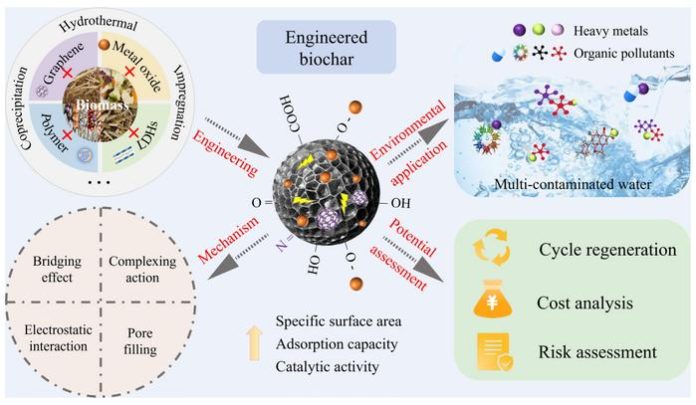
A new study reveals engineered biochar, a modified carbon material from waste biomass, is a powerful and affordable tool for simultaneously removing heavy metals and organic pollutants from wastewater, offering a sustainable solution to complex water pollution
The study, published in Biochar X, highlights the transformative potential of engineered biochar—a specially modified, carbon-rich material—as an affordable, highly efficient tool for simultaneously combating two of the world’s most challenging water contaminants: heavy metals and organic pollutants.
The research provides a strategic roadmap for adopting this sustainable technology to address complex water contamination globally.
Tailored structure for double-duty cleanup
Traditional water treatment methods often struggle when heavy metals (like lead and chromium) and organic chemicals (such as pharmaceuticals and dyes) coexist, as their combined presence is more toxic and difficult to treat than either pollutant alone. The review, a joint effort led by researchers at Guizhou University, details how strategic modifications have supercharged biochar’s natural properties.
Biochar, derived from heating plant and waste biomass in low-oxygen conditions, is naturally porous and possesses a large surface area, making it a good, low-cost adsorbent. Scientists have now created “engineered biochar” by integrating materials like metal oxides, polymers, or graphene into its structure. This process customises the material’s surface chemistry, allowing it to efficiently capture both positively charged heavy metals and complex organic molecules through a variety of mechanisms, including electrostatic attraction, pore filling, and bridging interactions.
High efficiency, low cost, and reusability
The study summarises numerous laboratory and real-world case studies demonstrating the material’s superior performance. For instance, composites made from biochar and specific metal oxides showed out-performing removal rates for lead and organic dyes compared to standard materials. Crucially, innovations like magnetic or polymer-infused biochars allow the material to be easily separated and reused after treatment, significantly lowering the overall operational cost of wastewater remediation.
Beyond its efficacy, engineered biochar offers significant environmental and economic advantages. Its production recycles vast quantities of agricultural and forestry waste, turning a disposal problem into a valuable resource. The wide availability of raw materials and low manufacturing costs make it an exceptionally viable and sustainable solution for water treatment, particularly appealing to developing regions and industries looking for green alternatives.
Path to full-scale implementation
While the future is promising, the researchers also outline key challenges for translating this lab-based success to full-scale water treatment plants. Future work must focus on optimising biochar formulations for site-specific contamination scenarios, ensuring the safe and easy regeneration of the pollutant-laden material, and conducting rigorous risk assessments to prevent any unintended ecological effects.
The publication provides a critical foundation, effectively serving as a strategic blueprint for governments, industries, and communities seeking to adopt a practical, scalable, and environmentally sound tool in the intensifying fight against water pollution. The findings are expected to catalyse further investment and collaborative research in this rapidly growing field of sustainable environmental technology.










